
Shop for Masdevallia & Other Pleurothallidinae
Belonging to the Pleurothallidinae subtribe, Masdevallia and Dracula orchids grow throughout Central and South America, although they can be found as far north as Mexico and as far south as Peru. They are, for the most part, cool growers and can be found at high elevations in the mountainous cloud forests where they thrive in high humidity. Some species grow right at the snowline, and it is not uncommon to see them become lightly dusted with fast melting snow. Still, others grow in warmer and somewhat drier conditions where the plants dry slightly between rains. The colors and flower shapes of this orchid group are incredibly diverse! Some of the hybrids have been found to have more vigor, making them easier to grow and bloom at intermediate temperatures while retaining the intriguing colors and shapes.
Light and Shade
In nature, the thinner-leaved species primarily grow in shady conditions (approx. 1200 foot-candles), so that if a hand is passed over the leaves it does not produce a shadow. There are, however, a few thicker-leaved species species that experience fairly bright, dappled sunlight (approx. 3500 foot-candles). Be careful in the summer not to overexpose the plants to direct sunlight.
Temperature and Humidity
Most Masdevallia are cooler growing. Many hobbyists grow these orchids successfully in air-conditioned rooms or in a basement under lights. These prefer day temperatures from 65°F to 75°F (18°C to 24°C), with night temperatures from 40°F to 60°F (5°C to 16°C). The colder you grow these orchids, the sturdier they will be. At lower temperatures, the flowers will also develop over a longer period. This results in a larger size bloom, as well as improved color and shape. During summer it is almost inevitable that there will be some hot spells, sometimes lasting several weeks. When this occurs the plants will be stressed and may develop black spotting. Keep the plants thoroughly shaded during this time to reduce leaf temperatures as much as possible.
There are a few Masdevallia species that do well in warmer areas where summer night temperatures stay above 70°F (21°C). These species include Masd. floribunda, Masd. striatella, Masd. kuhniorum, Masd. bicolor var. infracta, Masd. rima var. alba, Masd. bangii, Masd. minuta, Masd. attenuata, and Masd. echo. Day temperatures should still remain below 80°F (27°C).
Masdevallia benefit tremendously from high humidity around 70%. This can be achieved at home with the use of a humidifier or a humidity tray. Just make sure that the plant is not standing in water or the roots will rot.
Watering
If you examine the roots of these orchids, you will discover many fine hairs similar to root structures on Paphiopedilum. It is best to water the thin-leaved species as they approach light wetness, when the media is still evening damp to the touch but the pot is light. Thick, heavy-leafed species prefer to approach dryness at the roots, when the media is lightly damp to the touch.
Interestingly, we have found that if you keep the plants drier at the roots during hot spells you will avoid stem rot, which can occur very quickly. Misting the leaves lightly will keep them from shriveling. Once temperatures begin to cool off, resume regular watering again.
We always recommend watering in the morning, as this gives the leaves time to dry and avoid bacterial growth overnight. If possible, use water low in alkalinity, such as rainwater, distilled water, or reverse osmosis water. If you have a dehumidifier in your home, the water that collects in the tray is excellent for watering orchids.
Feeding
We highly recommend Green Jungle Orchid Food, specially formulated to provide orchids with the nutrients they would naturally encounter in their wild habitats. This is the fertilizer that we developed to use on our own plants in production, with excellent results for decades! This formula works best with water low in alkalinity (such as rainwater, distilled water, or reverse osmosis water). However, you may use tap water, keeping in mind that mineral buildup will require repotting more frequently, on the order of every 1 to 2 years. When potting in sphagnum moss, fertilize every 3rd watering year round.
Potting
Masdevallia thrive in a well-aerated medium that holds lots of moisture, while draining thoroughly upon watering. At Orchids Limited, we recommend potting these plants in New Zealand Sphagnum Moss. When using sphagnum, it is important to check for mix decomposition every 9 to 12 months and repot if necessary. Masdevallia are more tolerant of repotting than most orchids. Select a pot which, once the plant has been placed in the center, allows space for at least two years' growth. Remove all dead or dying roots from the plant, carefully taking off the old compost without causing damage to the live roots.
Should you wish to divide your plant at this time, each section should have a clump of 5 to 10 growths, in addition to any new leads. You can watch our video on dividing orchids here.
To avoid the transfer of orchid diseases, it is standard procedure to sterilize all cutting and potting instruments before using them on a plant. This can be done by flaming pruning shears with a butane torch, or by spraying with rubbing alcohol and wiping with a clean paper towel.
Pest Control
These orchids can attract spider mites in the summer, and slugs in the winter. To avoid getting mites, take the plant into the shower once a month and spray the foliage lightly with room temperature water. If you have spider mites, insecticidal soap sprayed 3 times, one week apart, should control them. To control for slugs, maintain a small sprinkling of slug bait over the months during winter months.
